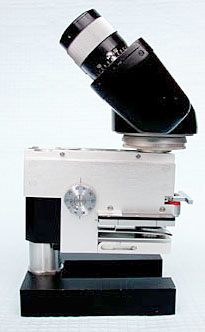Two major new resources
are offered this month:

Hold mouse over image
so door opens. Then click to enter museum
|
The Micropolitan
Museum of microscopic art forms, curator Wim van Egmond (The Netherlands).
Wim has used his own stunning
photomicrographs to create this extensive virtual museum to celebrate the
wonderful microorganisms around us.
Each room is devoted to
a major biological group. Why not pop back regularly and use the 'floorplan'
to explore each room in turn? There's plenty to see in the 'Desmid Dome',
'Bacteria Basement', 'Radiolaria Room' ... |
Microscopy
Primer by Frithjof Sterrenburg (The Netherlands).
The author has generously
offered his eight chapter illustrated book as a valuable online resource.
It covers both practical and theoretical aspects of the compound microscope
with plenty of practical tips, with particular reference to diatom observation.
It can be viewed online,
or downloaded as a 1.3 MByte zip file for offline browsing / printing. |
Articles
Accessories
for the McArthur microscope Mike Dingley (Australia) illustrates
and discusses some of the impressive accessories that were available for
the famous field microscope which Cooke, Troughton and Simms made to the
McArthur design.
Field
videomicrography An Open University McArthur microscope + battery
powered webcam = video microscopy in the field with a laptop! John Walsh
(Australia) describes this ingenious setup which gives surprisingly good
stills and video clips.
Tintinninae
No, not a further adventure of the cartoon character 'Tin Tin', but a delightful
illustrated look at a less well known group of protozoa with bell-like
shells. By Jean-Marie Cavanihac (France).
Drawing
your microscopic subjects. Part 1- Drawing from the screen of your computer
In this article, Walter Dioni (Mexico) describes a drawing technique
using image captures as a basis for drawing. His own and published drawings
of the protozoan Euplotes euristomum are used as an example.
Biodiversity
David Richman's (USA) studies of the amazing diversity of spiders in certain
habitats prompted this thought provoking essay on biodiversity from his
own perspective.
The
beginner's microscope? Paul James (UK) looks at the old toy microscope
of a good design which inspired his interest in microscopy, with his thoughts
on the toy microscopes then and now.
The
mucus belts of the Oscillatoria Wan Yu (China) describes and illustrates
a simple but effective way of staining and observing the mucus trails left
by these microorganisms.
Image
gallery: Living protozoa portfolio Jim Evarts (USA) shares some
impressive images of living protozoa which he has photographed with electronic
flash.
Topical
tips 11: Adding a lamp diaphragm (or field stops) to a modern microscope
without one Some modern microscopes in the budget to medium price
class do not have a lamp diaphragm. Ian Walker (UK) describes simple methods
to control the light field and hence improve such a microscope's performance.
Please note:
The
Micscape Editor's e-mail contact has
changed in July 2002.

